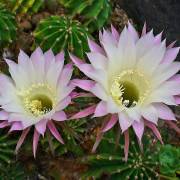Cactus queen of the night: main varieties and care options
Content:
Selenicereus large-flowered is known for its beautiful fragrant flowers that fall in love at first sight. This cactus is justifiably considered one of the most beautiful and unique in nature, because the rest cannot compete with it in grace and majesty. That is why Selenicereus (Selenicereus Grandiflorus lat.) Became famous among the people under the name "queen of the night".
Just from one of his nicknames, the skin begins to get goosebumps! In addition, the royal buds exude a persistent and pleasant aroma, which makes many flower growers give their hearts to this prickly beauty. They are not frightened by the fact that the fabulous beauty of the flowers of the plant appear only for one night, or that, due to the very long shoots of the cactus, which can reach several meters, it is difficult for a cactus to find a favorable placement. And this is not surprising, because all the efforts spent on cultivation are fully reimbursed when the moon cactus blooms.
Description of the cactus queen of the night
The night cactus selenicereus is a creeping plant. It belongs to dry-loving cacti. Among flower growers, the most popular type of this cactus is Selenicereus large-flowered, and its hybrids are also often found. In total, more than 20 species of this plant have been discovered.
This unearthly beauty arrived in Russia from the tropical rainforests of South America. The largest focus of their distribution in nature is the forests located in the Amazon River basin. Also often found in the flora of Jamaica, Cuba, Mexico. The habitual habitat of the flower is huge steep rocks and tall trunks of tropical trees, on which it is fixed with the help of its surprisingly long shoots and roots.
For your information! This plant is also referred to as the moonwort, creeping, serpentine, or dragon cactus.
In many nations of the world, the creeping cactus has become so iconic that legends, tales and songs have been written in its honor. The most well-known is the legendary tale about the emergence of this unique plant.
Main types
The following varieties are very popular among florists.
Selenicereus large-flowered
This flower is rightfully considered the crown, the pride of the entire genus Selenicereus grandiflorus, and in the common people - the queen of the night cactus, with very long climbing or creeping roots. It reveals the largest flowers of all representatives of the genus Cactus. The stems of this plant are relatively thin and fragile, as a rule, they have 7 or even 8 edges.
Note! The stems of this plant are very rich in vitamins D and C, therefore it is widely used in homeopathy.
The plant develops aerial roots as it grows.
The queen of the night cactus has breathtakingly beautiful flowers that exude a captivating subtle vanilla aroma. They are solitary whitish shades, very large and bloom, alas, at night. The flowering period can be up to several weeks.
Selenicereus Honduran
This unusual plant differs from its relatives from the Selenicereus group in its appearance. The fact is that its beautiful and delicate flower is surrounded by needle-like petals that resemble a sharp collar.
Other types
In general, in nature, there are about 30 species of this representative of the Cactus.Moreover, each of them has its own unique features. For example, a selenicereus uniculate flower can reach 40 cm in diameter, and this is an absolute record. But the shoots of the Selenicereus Anthonyanus cactus resemble fish skeletons, so people nicknamed it as "fish bone".
Home care
Many gardeners, experienced or just beginners, are afraid to start selenicereus and avoid it like fire. All this is due to the fact that many myths have been invented about this flower, that it is damn difficult to care for, too picky and capricious, it takes superhuman efforts to bring the flower to the flowering period. These unfounded rumors are dispelled below.
Temperature
This plant does not tolerate drafts and fluctuations in air temperature. This interferes with the development of the roots, and the cactus also stops sprouting. Such conditions also threaten with the fact that you may not see the beautiful flowering of Selenicereus for a long time.
If the temperature fluctuates between 2-3 ° C, the plant quickly sheds all the buds and even the opened flowers.
The rest of the plant is quite stable. It is even cold-loving in winter. So, in the period from the end of November to the beginning of March, it is advisable for Selenicereus to stay cool, namely at a temperature of 10-16 ° C (18 ° C is the maximum limit for this period). During the rest of the year, these cacti feel comfortable at a temperature of 18-25 ° C.
Lighting
It is very important for this princess to be in a well-lit place, preferably on the windowsill in the southern part of the house. After taking daily sunbathing, the flower grows much better and blooms more abundantly and often. These cacti are rightfully classified as one of the most light-loving indoor flowers.
Humidity
These flowers do not need additional manipulations to humidify the air and exist perfectly at medium humidity. But, if the florist has set himself the goal of achieving the most spectacular and beautiful flowering, then the air in the part of the house where the flower stands is still better to additionally humidify. But, most importantly, do not overdo it, as an environment that is too humid can be detrimental to a cactus.
Priming
Cacti love dry, lean soil the most. When it comes to selenicereus, these facts are worth forgetting. The lunar queen simply adores saturated, humus-rich soil. But it is worth paying special attention to ensuring that the substrate has good air and water permeability. To provide all the necessary conditions, it is enough to go to a flower or gardening store and buy a ready-made mixture for planting cacti or succulents and add charcoal or, for example, vermiculite there.
Watering
Watering this cactus is also no big deal. All that is required is to check the degree of drying out of the soil. If it is noticed that the top of the soil is completely dry, and the middle is only slightly damp, then this is a sure sign that it is time to water the prickly queen.
In winter, it is important to ensure that the soil under the flower is almost always dry. It is worth watering occasionally and making sure that the shoots do not dry out.
Excess moisture in the soil leads to the death of Selenicereus. Also, the deadly poison for a flower is hard water.
Top dressing
This plant should be fed twice a month, unlike many other house flowers. You also need to understand that an adult cactus will require more feeding than a freshly planted shoot. For a beautiful night princess, special fertilizers designed for cacti are best suited. They can be found in any specialty store.
Thus, there is nothing difficult in the content of a thorny flower. It is worth adhering to the simple rules described above, and the long-awaited flowering will certainly come. The main thing is not to miss this short moment, which lasts only one night.



















